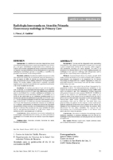Mostrar el registro sencillo del ítem
Radiología innecesaria en Atención Primaria
| dc.creator | Pérez Ciordia, Ignacio | es_ES |
| dc.creator | Guillén Grima, Francisco | es_ES |
| dc.date.accessioned | 2014-06-12T11:21:13Z | |
| dc.date.available | 2014-06-12T11:21:13Z | |
| dc.date.issued | 2007 | |
| dc.identifier.issn | 1137-6627 | |
| dc.identifier.other | 808 | |
| dc.identifier.uri | https://hdl.handle.net/2454/10828 | |
| dc.description.abstract | Fundamento: La solicitud de pruebas diagnósticas desde atención primaria presentan un aumento progresivo en el tiempo y una gran variabilidad interpersonal en su solicitud, que sugiere que se están aplicando servicios inefectivos. El objetivo es conocer las características de los demandantes de pruebas radiológicas (radiología general y ecografía) y cuantificar las pruebas innecesarias en atención primaria. Material y métodos: Estudio descriptivo transversal sobre una muestra en cluster de 23 centros de salud de Navarra en el mes de marzo de 2004. Se diseña un cuestionario específico para cumplimentar por el médico solicitante de la prueba diagnóstica. Se realiza análisis multivariante mediante regresión logística para estudiar la asociación entre pruebas innecesarias y las otras variables de estudio. Resultados: Se realizan pruebas al 9 por mil de la población estudiada. La variabilidad interprofesional en la solicitud de pruebas oscila entre 0 y 33,3 por cada 1000 tarjetas sanitarias para la edad infantil. Los estudios radiológicos solicitados con mayor frecuencia fueron los óseos (48,9%, LC: 42,4-55,5). En el 63,2% de las solicitudes no se realizaron modificaciones en el tratamiento previo a la solicitud de la prueba y el 57 % (LC: 52,4-61,7) de las pruebas realizadas se solicitan para descartar patología. El 24,7% (LC: 17,1-29,2) son pruebas innecesarias y en el 15,2 % (LC:10,7-18,2) hubo presión del enfermo en la solicitud. En el análisis multivariante se observan diferencias significativas para Rx de tórax, cambios en el tratamiento y ser presionado por el enfermo. Tras ajustar por las otras variables, la solicitud de una prueba innecesaria es 12,55 veces mayor si el médico se siente presionado por el enfermo. Conclusiones: Debe analizarse la correcta indicación de la radiología, especialmente de la ósea, y se debe potenciar al radiólogo en la decisión última de realizar la prueba diagnóstica. | es_ES |
| dc.description.abstract | Background. The request for diagnostic tests proceeding from primary care shows a progressive increase over time and a great interpersonal variety in the requests, which suggests that ineffective services are being applied. The aim is to determine the characteristics of the those making requests for radiological tests (general radiology and echography) and to quantify the unnecessary tests in primary care. Methods. Cross-sectional study of a cluster sample of 23 health centres of Navarre in the month of March 2004. A specific questionnaire was designed to be completed by the doctor requesting the diagnostic test. Logistic regression to study the association between unnecessary tests and the other variables of the study was used. Results. Tests were asked for on 9 per thousand of the population studied. The inter-professional variability in the request for tests oscillated between 0 and 33.3 per 1, 000 health cards of children's age. The radiological studies requested with greatest frequency were osseous (48.9%, IC: 42.4-55.5). In 63.2% of the requests no modifications were made to the treatment prior to the request for a test and 57% (IC: 52.4-61.7) of the tests carried out were requested to rule out pathologies. Twenty-four point seven percent (IC: 17.1-29.2) were unnecessary tests and in 15.2% (IC: 10.7-18.2) there was pressure from the patient in the request. In the multivariant analysis significant differences were observed for thorax Rx, changes in the treatment and pressure from the patient. After adjustment for the other variables, the request for an unnecessary test is 12.55 times greater if the doctor feels under pressure from the patient. Conclusions. The correct indication for radiology must be analysed, especially in osseous radiology, and the role of the radiologist in the final decision on carrying out the test must be strengthened. | en |
| dc.format.mimetype | application/pdf | en |
| dc.language.iso | spa | en |
| dc.publisher | Gobierno de Navarra | es_ES |
| dc.relation.ispartof | Anales del Sistema Sanitario de Navarra, 2007, 30(1). Págs. 53-60 | es_ES |
| dc.rights | © Gobierno de Navarra. Departamento de Salud | es_ES |
| dc.subject | Atención primaria | es_ES |
| dc.subject | Servicios de salud | es_ES |
| dc.subject | Pruebas radiológicas | es_ES |
| dc.subject | Primary health care | en |
| dc.subject | Health services needs and demand | en |
| dc.subject | Assessment radiology | en |
| dc.title | Radiología innecesaria en Atención Primaria | es_ES |
| dc.title.alternative | Unnecessary radiology in Primary Care | en |
| dc.type | Artículo / Artikulua | es |
| dc.type | info:eu-repo/semantics/article | en |
| dc.contributor.department | Ciencias de la Salud | es_ES |
| dc.contributor.department | Osasun Zientziak | eu |
| dc.rights.accessRights | Acceso abierto / Sarbide irekia | es |
| dc.rights.accessRights | info:eu-repo/semantics/openAccess | en |
| dc.identifier.doi | 10.4321/S1137-66272007000100006 | |
| dc.relation.publisherversion | https://dx.doi.org/10.4321/S1137-66272007000100006 | |
| dc.type.version | Versión publicada / Argitaratu den bertsioa | es |
| dc.type.version | info:eu-repo/semantics/publishedVersion | en |


